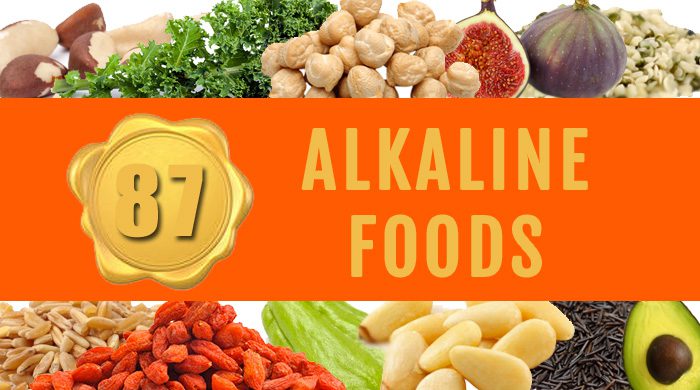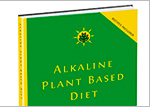Alkaline Food List And Its Benefits

This alkaline food list is based on the Dr. Sebi food guide and includes non-hybrid alkaline whole plant foods that naturally support keeping the blood at a 7.4 pH, which is an inhospitable environment for disease and an excellent environment for the immune system to thrive in.
Alkaline Food List
Vegetables
- Amaranth greens aka callaloo
- Avocado
- Bell Peppers
- Chayote
- Cucumber
- Dandelion greens
- Garbanzo Beans (chick peas)
- Green Banana
- Izote Cactus
- Kale
- Lettuce (all, except Iceberg)
- Mushrooms (all, except Shitake)
- Nopales – Mexican Cactus
- Olives
- Onions
- Purslane (Verdolaga)
- Sea Vegetables (wakame/dulse/arame/hijiki/nori)
- Squash
- Tomato – cherry and plum only
- Tomatillo
- Turnip greens
- Watercress
- Zucchini
Fruits
- Apples
- Burro Bananas
- Berries – all varieties except cranberries
- Cantaloupe
- Cherries
- Currants
- Dates
- Figs
- Grapes -seeded
- Key Limes
- Mangoes
- Melons -seeded
- Orange (Seville or sour preferred, difficult to find )
- Papayas
- Peaches
- Pears
- Plums
- Prickly Pear (Cactus Fruit)
- Prunes
- Raisins -seeded
- Soft Jelly Coconuts
- Soursops
- Tamarind
Nuts
- Brazil Nuts
- Pine Nuts
- Walnuts
Seeds
- Hemp Seed
- Raw Sesame Seeds
- Raw Sesame “Tahini” Butter
Spices
- Achiote
- Basil
- Bay leaf
- Cayenne – African Bird Pepper
- Cilantro
- Coriander
- Dill
- Habanero
- Onion Powder
- Oregano
- Powdered Granulated Seaweed
- Pure Sea Salt
- Sage
- Savory
- Sweet Basil
- Tarragon
- Thyme
Grains
- Amaranth
- Fonio
- Kamut
- Quinoa
- Rye
- Spelt
- Tef
- Wild Rice
Teas
- Alvaca
- Anise
- Chamomile
- Cloves
- Fennel
- Ginger
- Red Raspberry
- Sea Moss Tea
Alkaline Water
- Natural Spring Water
Why Eat From an Alkaline Food List?
Nature originally provided natural plant foods that were slightly, and sometimes highly alkaline. The alkalinity of plants was determined by their genetics, and their access to specific minerals in various ratios.
Natural plants are non-hybrid alkaline plants, while the hybridization of plants or the combining of two plants through unnatural cross pollination altered their chemical structure and produces acidic plants.
The alkaline food list is based on non-hybrid plant foods and plant foods whose alkalinity hasn’t been compromised.
More: Learn about the alkaline plant foods on the Dr. Sebi Nutritional Guide »
Being part of nature, people’s requirements for nutrients developed in relation to its natural food source, which are natural alkaline plants.
These plants naturally supported the slightly alkaline 7.4 pH of the blood, which the body works diligently to maintain.
When we consume food the body digests the food and breaks it down to an ash that contains its key components, which are minerals and other compounds.
The pH of the ash is determined by the concentration of its alkaline components like potassium, calcium, magnesium, and iron, verses its concentration of acidic components like sulphur, phosphorus, and chlorine.
Alkaline Forming
Interestingly many fruits are acidic outside the body but when they are digested they leave behind an alkaline ash, and are considered to be alkaline forming.
Natural plant foods are naturally alkaline or alkaline forming in contrast to meat, dairy, and processed foods that are acidic.
Alkalinity and PH
The ratio of carbohydrates, fats, protein, minerals, vitamins, and phytonutrients in alkaline non-hybrid plants all naturally support homeostasis of the organs and metabolic functions in the body, while providing an alkaline environment in the blood that kills disease.
The pH level in the body varies depending on the area of the body, so the body will distribute nutrients the way the body needs them from the alkaline foods.
The blood supplies oxygen and nutrients to every cell of the body, and the blood must be kept at a around 7.4 pH to properly support this function.
Metabolic acidosis will occur if the blood’s pH drops below 7.4 (a slightly alkaline range of 7.35 to 7.45), which can result in shock and death.
Maintaining a 7.4pH in the blood is so vitally important to the health of the entire body, consequently the body will leach the alkaline calcium mineral from bones to add to the blood to maintain its required pH level.
The blood is the equilibrium point of homeostasis, and its health determines the health health of he whole body because it feeds the whole body.
The body will use buffering systems to maintain the correct correct pH in the blood. When acidic foods are eaten chronically the body will continuously pull alkaline material from bones and fluid throughout the body.
This will lead to the development of chronic disease including: include osteoporosis, candida overgrowth, acid reflux, weakened immune system, confusion, anxiety, and low energy.
Alkalinity Supports the Immune System and the Death of Disease
Dr. Vega demonstrated the effects of alkalizing the body on disease. He tested the pH levels of the urine of his cancer patients and found them all to be acidic.
He analyzed the blood of his patients while they were acidic and found the environment paralyzed white blood cells and allowed for the proliferation of pathogens and toxins.
He then administered goji berry juice to his patients and raised the pH of their urine to 7.4 and then took blood samples again.
He saw that the alkaline environment woke up the paralyzed white blood cells, and they were then able to clean the blood of pathogens and toxins.






